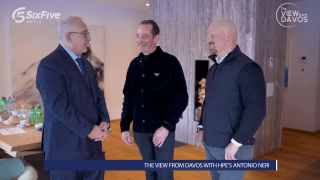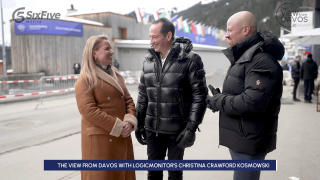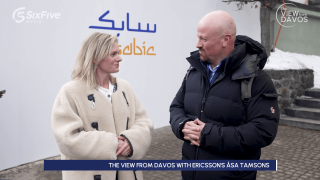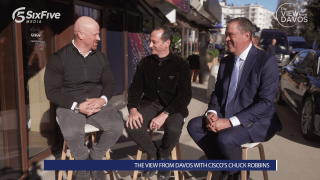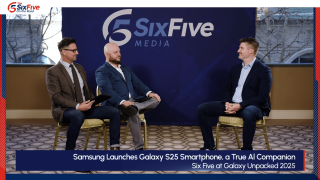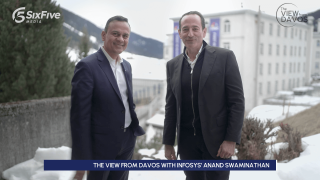There’s no question about it – AI is changing the workforce across entire industries and ecosystems. Can employers build trust while implementing AI? Patrick Moorhead and Daniel Newman are joined by Workday’s Jim Stratton, Chief Technology Officer on this segment of The View From Davos, for a conversation on the transformative power of AI, responsible implementation, and the evolving landscape of work.
Tune in as they cover:
- Key themes and technology trends emerging from Davos
- How Workday is contributing to the global technology landscape
- Jim Stratton’s vision for the future of work and innovation at Workday
- The impact of global economic changes on technology strategies
- The importance of transparency and human-machine to ensure responsible use of AI, especially in HR and talent management
Learn more at Workday.
Watch the video below, and be sure to subscribe to our YouTube channel, so you never miss an episode.
Or listen to the audio here:
Disclaimer: The View From Davos is for information and entertainment purposes only. Over the course of this webcast, we may talk about companies that are publicly traded and we may even reference that fact and their equity share price, but please do not take anything that we say as a recommendation about what you should do with your investment dollars. We are not investment advisors, and we ask that you do not treat us as such.
Transcript:
Patrick Moorhead: The Six Five is On the Road with a View from Davos. Conversations have been incredible here. World Economic Forum is a great event, its unique event in that it intersperses not only technology, government regulation, AI, really looking at this public-private investments and rollout. They’ve been pretty good so far, Dan?
Daniel Newman: Yeah, it’s been a great event, Pat, and we’ve been up and down the promenade inside and outside of the perimeter and there is just so much going on. I mean we’ve hit this massive inflection, right? We’ve got new administration. Obviously there’s a continuum of feelings about that. Some people are very inspired, some people are concerned, but this event is always one of those places where the future is discussed at scale. And when you say tech and regulation, policy, economics, all coming together, these things, it feels like in our world tech people that everyone gets it all. But I mean that place where the leaders have a chance to really sit down and understand what’s happening, how does this stuff work, how do we keep it safe? How do we make it drive economic value? This is where a lot of it gets done and by the way, as a couple of chip guys, best density on the planet as it pertains to meetings per hour with people you want to meet with.
Patrick Moorhead: Yeah, that’s right, Dan. And a lot of the conversations we’ve been having, it’s almost like the punchline and how to get the most out of AI ends up in a human conversation, getting people out of their comfort zone. How do people in the technology interact and I can’t imagine a better person to have this conversation, Jim. Workday, you’re CTO there. Thanks for coming on the show.
Jim Stratton: Thanks for having me.
Patrick Moorhead: Absolutely. Probably the best place to start here is, and I don’t know if this is your first World Economic Forum, maybe not, but what do you want to accomplish here? What are your objectives? Is this is primarily a customer-facing meeting, government officials, enterprises?
Jim Stratton: It’s all of the above actually. And we have a good diverse team here too, but we’re covering all those bases. It’s the government entities, the press, media, talking with customers, talking with prospects, talking with other technology companies, talking with our own partners so some of the large companies that we partner with. As you said before, just the number of meetings and the diversity of those meetings of people that you want to meet with, it’s pretty incredible what you can get done in a week here.
Patrick Moorhead: Yeah, the density is high, isn’t it?
Jim Stratton: It is.
Daniel Newman: Price performance in area. We’re covering it. But we’re actually, Jim, you lead a very, very important software company. You drive a lot of the biggest companies in the world, very familiar with what you’re doing, but really interesting if you heard what I was saying in the buildup about the people catching up part. We talked to 213 CEO, companies over a billion in revenue and one of the gaps that they all seem to be having is the tech is very accessible to implement AI, but they’re having a really hard time getting it implemented and getting culture to buy in and turning proofs of concept into scale deployments. I mean as CTO of Workday, this has to be something you and your team are thinking about both with your customers and of course within the company. Can you talk a little bit about how you’re thinking about the evolution of building culture, trust, skills for the AI future?
Jim Stratton: Yeah, it’s a really interesting topic and talk about it maybe on two different fronts. One, in the product and what we’re building there and how we work with customers to drive uptake and value realization out of that. Then also internally within our own operations, I think like a lot of other large companies, even in the tech industry, we spent a while trying to figure out how we were going to use it for our own internal operations and we started with some easier things like developer co-pilots and just trying them out, try a proof of concept and get some of your best developers in there and see how they like it and they liked it. They started using it. They started seeing that actually this is pretty good and I’m getting more efficient, I can get more done. And we’ve started that across different… We then set up internally a strategic walk across all the different parts of the business and the work that gets done and what are some best of class tools that we can use to get in the hands of users.
And we start with small pilots and then word of mouth grows and people start seeing. At this point now we leverage it across quite a lot of the business that we do internally and it’s great. I can be more efficient, I can get stuff done. There’s things that used to take me hours or I couldn’t even do at all that are very, very easy to get done. So I think it’s mostly about taking that first step and trying it out and seeing that actually this is not as scary as I was worried about and I can use it to actually get some productivity gains, but I’m still doing the same job that I was doing. I’m just able to do it more efficiently or to cover more conversations. You just get more efficient at what you’re doing. And the same is true in what we put in the hands of our customers and it is about taking that first step, trying it out, getting a small group of folks to use it, and then they start to see the real productivity gains.
So if you look at something like a recruiter agent, so that today is helping talent acquisition professionals source 30 to 35% more so they can get more done with their own time, with their own job. They’re filling seats 20 to 30% faster, so the timeline to actually fill a particular role. Then if you add in for us a product that we call Talent Optimization, that actually helps companies retain 20 to 30% higher retention rates, that’s money directly back into customer’s hands. So they start seeing actually we can be more efficient in our operations and that starts to build this flywheel momentum to start taking up more. So that’s how we’re building it. It takes time. People need to get their feet wet with it and it does take time to start building that momentum.
Patrick Moorhead: Yeah, one of the big conversations about AI obviously has been around trust and it’s evolved and has crescendo when it gets into things like agents that are not just, okay, I can look something up and it’s this intelligent chatbot, but actually does something. And trust can mean I’m getting the right results that I can trust, but can also mean only having the right people looking at certain things. And it’s funny whether it’s ERP, PLM, HRM, HCM, all the different M’s out there in the enterprise. It all needs to be trusted, but I believe there’s a higher bar when it comes to people and that’s what your company is all about here. How are you ensuring that that level of trust is high in what you do and what you’re offering to your customers so they can feel like they can use this with confidence and their employees can too? The last thing we need is somebody doing a query and pulling back what somebody makes when they’re not supposed to be looking at that, intelligently creating an agent to go do something nefarious, maybe give somebody a pay raise.
Jim Stratton: No, it’s a great question. I’ll come at that from a couple of different ways. So first we started from the very beginning with building out a responsible AI framework. So we published our own AI principles. We did that first in 2019 and revisited that actually just about 18 months ago. We put in place, we leveraged the NIST risk management framework and we leveraged that across our development for all of our AI products. So that helps us put frameworks and guardrails around how we develop and how we test. And before we deploy software out there, we also provide a lot of transparency and visibility in the product itself about why did the machine make this decision or make this recommendation really, and that’s going to continue to be true. Providing that transparency about what the AI is doing underneath is going to be critical for developing trust. But the other thing that’s really key is for us and for a long time to come, I think it’s about human machine teaming.
And coming back to that example of the recruiter agent, there’s still a human that’s in that workflow and the AI is developing recommendations and saying, “I think these are probably the 10 best candidates based on the job requisition criteria and your sourcing selection criteria and location and all the other things that go into it,” but you’re still putting that in the hands of a human to make the decision about actually we’re going to reach out to these three people and start scheduling interviews. And that still flows through humans making the decision about actually I think this person’s the best fit. And so it really is about that human machine teaming side of things. And I think that’s going to continue to be the case for quite a long time. And for us agents are, they’re not task-based agents, they’re really role-based agents. It’s a broader, more complex concept than just task-based agents that you hear a lot about. But those are going to develop more capabilities over time and eventually over time as they continue to grow in their skills and capabilities, they’re really going to become full-fledged members of teams. They’ll really start to become part of your digital workforce now.
Daniel Newman: Interesting. That’s really exciting. By the way, every time you say a human machine, you’ve got to pay me a quarter. I wrote a book called Human Machine, I published it five years ago, so I just want to make sure we get paid. Let’s do that after the show. But in all seriousness, to wrap this up, you started down a path I’d like to finish you there. So as you see these agents get smarter and we’re seeing it, we actually did a study, we see about 5 trillion in costs that can be pulled out of current workforces through the implementation of agents successfully over the next 18 months. It’s going to happen. You also have the culture. You’re basically saying, “I want the company to adopt this stuff. I want our employees to love all this great technology.” And in some ways they’re looking at it going, “Does this replace me?” How do you think… How does Workday think about the workforce in a way that they make sure that you can really build the culture, build the investment, build the buy-in, and at the same time they understand that if we do this well, we’re going to grow productivity, we’re going to up-skill the workforce and everybody’s going to have an opportunity to stay, or many.
Jim Stratton: No, I think it’s exactly that. So this particular AI revolution that we’re in the midst of right now, it’s an interesting double-sided coin in that it will displace certain types of workloads that, I mean, we all know that. We all see it already. There are certain types of work that are going to be easier to automate away, but it also provides the opportunity for re-skilling, for up-skilling. It makes it… If you focus on skills-based management of the workforce, which many of our customers are currently doing today, we do ourselves internally at Workday, but we believe enterprises are moving that direction in general. That allows you to focus on what skills gaps you have within the work that you need to get done. It allows you to also train your teams, how to up-skill, how to re-skill them and retain those folks even if the type of work that they were doing before got displaced, still other work that needs to get done. And so it is really this interesting two, two-sided thing where yes, it’s going to displace certain types of workload, but it also is the thing that is going to allow us to go learn to do the new thing that we need to do.
Daniel Newman: Well, Jim, every industrial revolution, I think I was saying to somebody just recently that when they got rid of the gas lighters, we use gas lighters differently now, but there used to be gas lamps and every night they got to climb the ladder, light the lamp, and people would say, “Electricity is going to take everyone out of the job.” I mean, we’ve come a long way from there, but I think with each of these revolutions we see that there is more productivity gain. Sometimes they’re prune first, and grow later. We’re testing that right now. But Jim, I’d love to take some more time in the future, talk more. I know Davos here, 15 minute blocks, you can at least have six meetings in that time and it can all be highly productive. And when we can’t meet, we’ll have our agents do it.
Jim Stratton: Perfect.
Daniel Newman: So all right, thanks for joining us at Six Five.
Jim Stratton: Thanks for having me.
Daniel Newman: And thank you everybody so much for joining The Six Five here with a View from Davos. We appreciate you being part of our community. Hit subscribe, watch all the covers. We have so many great interviews on the ground and we have so much more great insights that we unfortunately can’t share with you because that’s what you get when you’re in the room. All right, from Patrick and myself, time to say goodbye. We’ll see you all later.


